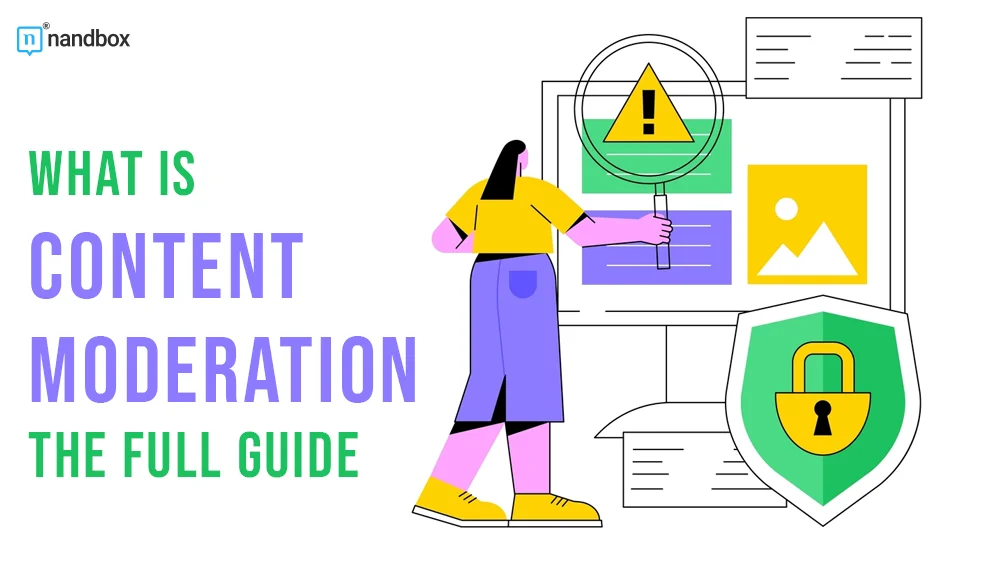In today’s fast-paced era, content creation is something that is advancing each and every day. That caused the infinite need for content moderation. Content moderation has a significant impact on the online experience. It keeps digital spaces civil, safe, and free of any offensive material. We’ll go into the topic of content moderation in this comprehensive guide. We will cover its significance, difficulties, best practices, and function in creating a positive digital ecosystem. In this guide, we will discuss the meaning and definition of content moderation, it’s importance, and how it shapes the outline of content creation and benefits it. Dive head-in with us in this comprehensive guide and learn all there is to learn about content moderation.
What is Content Moderation? A Quick Overview

Content moderation is all about adjusting safety and monitoring everything related to online content. It is like managing, reviewing, and editing generated content across all platforms. The main goal of content moderation is to balance freedom of speech while protecting users from any harmful, extremely sensitive, or offensive content. That includes the content of images, videos, texts, or any other form of online content that a user may find while browsing the internet. Expressing oneself can be good for everything, but unfortunately, some people tend to disregard feelings or emotions. Meaning that they can write something that is harmful to someone else without considering it. That is when content moderation is of extreme importance and great benefit for online communities. In the following paragraph, we will discuss the importance of content moderation and how it makes the internet a better and much safer place.
The Importance of Content Moderation
There are many benefits that content moderation offers. It allows you to create a safe online space, help people write positively, safeguard reputations and brand names, and water down any legal risks. Let’s discuss each advantage on it’s own and in a much more detailed way.
What is Content Moderation? Creates a Safe Online Space
Content moderation plays a crucial role in maintaining safe online communities for all users, shielding them from hate speech, abuse, and explicit content. This includes protecting excluded communities and minors, as well as other vulnerable users. Unfortunately, we humans tend to be a bit cruel with our words. There is even a saying that says, “Words can cut deeper than swords.” I tend to believe that this is true. That is why moderating and managing your content will indeed help your fellow humans enjoy a piece of content free of hate and negativity.
It Helps Brands Preserve or Protect Their Reputations
It is of crucial importance that brands actually maintain their image and reputation in order to lead the market and keep their loyal customers. However, with a poor content moderation strategy, a brand’s name or reputation can be stained. Let’s say for example, that if a certain supermarket started making online marketing campaigns regarding a certain product and used some offensive words or words that could be sensitive when used in some communities, these campaigns would definitely be crossed out by people! Additionally, people would lose faith in this brand and boycott it. This could lead to a drop in this brand’s stock and cause it to lose a bunch of money. That is why brands in general should have a great content moderation strategy and a team to execute this strategy in order to protect their names and care well for their clientele.
Reducing Legal Risks
An online platform may be subject to legal action if it hosts harmful or illegal content. This could lead to lawsuits and a lot of legal hassles that could shut down the platform and make it lose a lot of money invested in it. By assisting media in adhering to laws and regulations, content moderation lowers the possibility of legal action. That is why it is of crucial importance to create a content moderation strategy that covers all legal restrictions and makes sure it adheres to them.
What is Content Moderation? A Tool That Enhances User Experience and Takes It to a Whole New Level
When people find a platform that has safe content, they automatically opt for it. Statistics proved that 56% of people voted positively for Google’s safe search. That is an option that Google applied recently that allows kids and teens to surf the internet in a more flexible way. If we take this as an example, we’ll find that the majority of internet users or online platform visitors will actually opt for visiting links that have a higher rate of content moderation. This allows them to explore the internet without any guards. Simply put, content moderation improves the user experience by removing offensive or irrelevant content, which promotes participation and communication in online communities.
Encouraging Healthy Discourse
By facilitating civil and productive dialogue, content moderation creates an atmosphere where people can freely express their opinions and points of view. That is, regarding everything without worrying about retaliation or abuse. This opens the door for peaceful internet usage.
The Challenges That You May Face With Content Moderation
The word “scale” is one where you should focus when it comes to the challenges of content moderation. Millions of photographs and videos have been shared on thousands of platforms on a daily basis. The overwhelming majority of those are the kinds of information that billions of people regularly browse through on social media. However, a tiny portion of them are not so benign. Furthermore, it is important to emphasize that even a tiny portion of the billions of uploads that occur every day adds up to a sizable amount. Consider this statistic to gain a better understanding of the scope of the issue that platforms are facing: 350 million photos are uploaded to Facebook every day, according to Business Insider.
It is easy to dismiss content filtering as a process that complex algorithms have streamlined. Here, using AI is unquestionably a crucial step. 350 million photos a day is just too many for humans to handle. Still, the method relies heavily on human judgment for the final decision, and this may be where the real expense of content filtering lies. In order to clarify, content moderation does not include searching through millions of photos of puppies to find instances of copyright infringement. The reality is even darker for individuals who work as content moderators.
What Is Sensitive Content? The Definition and Relation To Content Moderation
The range of sensitive content that requires moderation is wide. As are the reasons and methods your team should use to filter it, as well as the potential intentions behind it. A user might unintentionally share their home address or any other data that is personally identifiable that they would like you to delete, for instance. However, somebody else might “dox” someone, in which case your team would have to both delete the victim’s private information and punish the one who first posted it. Hate words or speech, explicit photos or videos, nudity, spam, and fraudulent content detract from the goal of your company, disrupt users’ experiences, and erode community trust. Depending on the demographic you serve and their degree of maturity, your business could reserve their verdict on what UGC has to be moderated.
Types of Content To Moderate
Written messages are common to use, but the majority of content, like texts, pictures, and videos, needs content moderation in an efficient way. Let us explore together the three types of content to moderate and that is exactly what we will discuss in the following paragraph.
Text

The majority of the digital content is shared text, which is present everywhere and goes with all visual stuff. For this reason, the ability to moderate text should be granted to all platforms that host user-generated material. The majority of text-based material found on digital platforms is composed of:
- Blog articles
- Lengthy posts
- Social media posts
- Video “content” transcripts
- Job-boarding posts (Such as the ones on LinkedIn)
- Posts that include a survey or a certain forum
Images

Pictures, photographs, images, or whatever synonym you need to use also have content that you should moderate. There are some guidelines that you need to use in order to moderate visual content. However, the process of moderating visual content is not as complicated as it sounds. To stay safe and avoid harming anyone who will have access to your images, you must actively follow the process of eliminating any words considered harmful or sensitive.
Videos
This is where it all gets tricky. You can moderate video content but unfortunately, you wouldn’t be able to fully delete some scenes that may be considered triggering or violent. These scenes could have some content that is harmful but you wouldn’t be able to eliminate them. That is because they could be of great importance to the context of the scene that your video contains.
Final Thoughts on Our What is Content Moderation Guide!
Now that you know the importance of content moderation, you should work on creating a strategy that your business benefits from. There are various AI tools that have been developed in this technological era to help humans generate and modify their content. Content moderation, after all, helps you moderate and adjust content that is suitable for everyone. With tools like the ones newly presented nowadays, you can achieve your target faster, easier, and in a safer way.








